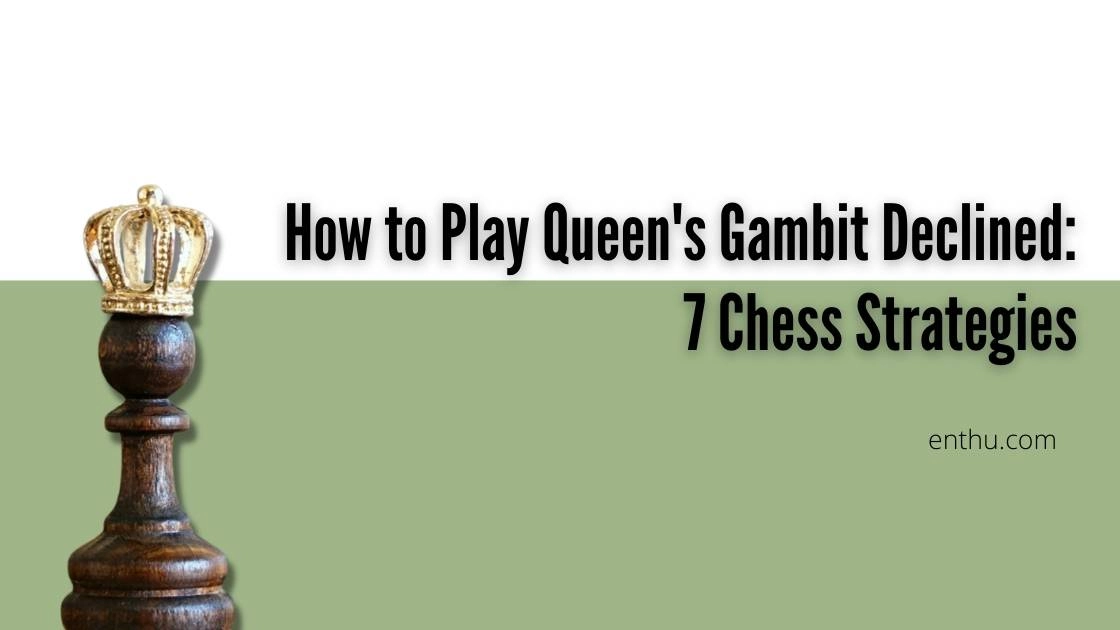Chess is all about plans and strategies. In fact, a chess player without any plan is not a player at all.
I guess that’s why Mikhail Chigorin said, “Even a poor plan is better than no plan at all.”
However, you need to study various opening strategies, middle game, and endgame strategies to come up with a proper plan.
What is Queen’s Gambit?
When Netflix’s Queen’s Gambit, starring Anya Taylor-Joy, hit OTT platforms, I received countless messages from friends and family asking about the Gambit. If you’re curious, here’s the answer.
The Queen’s Gambit is one of the oldest chess openings for White, starting with 1.d4 d5 2.c4. White uses these moves to control the center, offering the c-pawn to lure Black into weakening their d-pawn. Because it involves a sacrifice, it’s called a gambit, and it’s named “Queen’s” because it starts on the queenside.
Interestingly, the Queen’s Gambit is often called a pseudo-gambit. Unlike the King’s Gambit, the pawn that White offers is usually regained or safely ignored by Black, making the “sacrifice” largely unprofitable for the second player. Confused? Understanding the Queen’s Gambit Declined will make it crystal clear.
1. What does Queen’s Gambit Declined mean?
***Did you know in the 1927 World Championship between Alexander Alekhine and José Raúl Capablanca 32 out of 34 games began with Queen’s Gambit Declined?***
Most Chess scholars consider this opening as a part of studying Queen’s Gambit, which is true. After all, it’s an answering strategy to that White opening.
Let me tell you again, the moves are: 1. d4 d5 2. c4
White opens with Queen’s pawn at d4.
Black balances it by playing its Queen’s pawn at d5.
White lures Black by forwarding the c-pawn at c4.

Now, if Black decides to take the c-pawn, then it is Queen's Gambit Accepted (2. C4 dxc4).
However, if Black decides to decline the pawn, it’s Queen’s Gambit Declined.
When the White will open with Queen’s Gambit and offer the c4 pawn, the second player, aka Black, is going to decline the pawn. In short, it’s Black’s answering strategy White’s Queen’s Gambit.
2. How Can Black Decline White’s c4 Pawn?
The most common move to decline this Gambit is playing 2…e6. It’s a traditional move, and it comes with its own advantages and disadvantages.
Advantages:
It secures a stronghold for Black over the center with the pawns on e6 and d5.
It clears the path for the dark-squared bishop on f8, which can be developed to e7. It provides an opportunity for castling.
Disadvantages:
Playing e6 ends up blocking Black’s light-squared bishop temporarily, which otherwise brings lots of prospects.
Besides the traditional Declining strategy, there are plenty of other answering strategies. Most of them are interesting, attacking, and also bring out dramatic consequences on the board.
So, here’s a list of Queen’s Gambit Declined Strategies for each aspiring Carlsen out there.
Keep reading to find out how to play Queen’s Gambit Declined.
Queen’s Gambit Declined: 7 Chess Strategies
1. Slav Defense
This strategy is called “Slav Defense” because of Slavic masters like Alapin, Vidmar, Alekhine, and Bogoljubov’s contribution in developing the theory.
Even though it was recorded as early as 1590, it became popular in the 1920s. At present, GMs like Vladimir Kramnik, Ivanchuk, and Vishwanathan Anand also used it to defend against White’s 2. c4.
**Vladimir Kramnik won the 2006 World Championship against Veselin Topalov by playing Slav defense in six of the 8 chess games.**
How To Play
There are several variations of Slav defense.
The traditional Slav defense is: 1. d4 d5 2. c4 c6
With this move, Black can continue pressurizing the pawn at c4 and, at the same time, clears the path for the light-squared bishop.
The Exchange Slav: 3. cxd5 cxd5
It results in a symmetrical board, followed by very dull moves, such as: 4. Nc3 Nf6 5. Nf3 Nc6 6. Bf4 Bf5 7. e3 e6 8. Bd3 Bxd3 9. Qxd3 Bd6 10. Bxd6 Qxd6
When White plays an early e3
In this variation, the series of best moves is: 1. d4 d5 2. c4 c6 3. Nf3 Nf6 4. e3 Bf5.
The Main Line: 3. Nc3 Nf6 4. Nf3 dxc4
In the mainline of the Slav Defense, Black continues to exert pressure on the c4 pawn, threatening to attack.
3. Albin Countergambit
Chess legend Cavallotti was the first player to use this against Salvioli in 1881 during the Milan tournament.
However, its name comes from Adolf Albin, who used it against Emanuel Lasker in New York in 1893.
Even though it’s less popular at top tournaments, the Russian grandmaster Alexander Morozevich successfully implemented it in the 2000s.
How to Play
The initial moves are: 1. d4 d5 2. c4 e5 3. dxe5 d4
Now, the White’s 3. dxe5 is the main move. Next, instead of answering with 3…dxc4, which can lead to 4. Qxd8+, Black with play 3…d4.
By doing this, Black is trying to lead White to the infamous Lasker Trap.
The series of moves for Lasker Trap is: 1. d4 d5 2. c4 e5 3. dxe5 d4 4. e3 Bb4+ 5. Bd2 dxe3 6. Bxb4 exf2+ 7. Ke2 fxg1=N+
4. The Chigorin Defense
The Chigorin Defense is a chess opening named for 19th-century Russian master Mikhail Chigorin.
At present, it’s an unpopular opening, which gives you the advantage to use it as a surprise weapon.
Alexander Morozevich and Vasily Smyslov used this defense several times.
How to Play
The initial moves are: 1. d4 d5 2. c4 Nf6.
Next, the Black brings out the knight to threaten the d4 White pawn.
In the next step, the White plays any one of the three moves: 3. cxd5; 3. Nf3; or 3. Nc3.
If the White plays 3. Cxd5
The series of moves will be: 3. cxd5 Qxd5 4. e3 e5 5. Nc3 Bb4 6. 6. Bd2 Bxc3 7. bxc3 Qd6 8. Bd3 Nf6 9. Ne2 0-0 10. 0-0.
OR
3. cxd5 Qxd5 4. Nf3 e5 5. Nc3 Bb4 6. Bd2 Bxc3 7. Bxc3 e4 8. Ne5 e3 9. fxe3 Nxe5 10. dxe5 Ne7
If the White plays 3. Nf3
The series of moves will be: 3. Nf3 Bg4 4. e3 e5 5. dxe5 dxc4 6. Qxd8+ Rxd8 7. Bxc4 Nxe5
If the White plays 3. Nc3
In this case, you, aka the Black, can respond with 3. … dxc4, 3. … Nf6 or 3. … e5
5. The Lasker Defense: Main Variation
The line is named after the first German world champion, Emanuel Lasker.
How to Play
The series of moves is: 1.d4 d5 2.c4 e6 3.Nc3 Nf6 4.Bg5 Be7 5.Nf3 0-0 6.e3 h6 7.Bh4 Ne4 8.Bxe7 Qxe7
In this variation of the main line, the Black forces the exchange of two minor pieces and thus replays his defense.
6. The Tarrasch Defense
This Defense is named so after the German player Siegbert Tarrasch. When masters like Wilhelm Steinitz refuted this line, he continued to advocate it.
It’s one of the most riskiest declining strategies. It will either destroy chances to win or make sure you win.
How to Play
The series of moves is: 1. d4 d5 2. c4 e6 3. Nc3 c5
When the White knight is pressuring the Black on d5, Black brings out the bishop on c5 to neutralize the power and threatens the d4 pawn.
7. The Vienna Variation
In the Vienna Variation, Black immediately goes for complications.
How to Play
The series of moves is: 1. d4 d5 2. c4 e6 3. Nc3 Nf6 4. Nf3 dxc4
In this variation, Black takes the c4 pawn and allows White to control the center with moves 5. e2-e4.
Later on, Black brings forwards its dark-squared bishop on b4 to attack the white center with c7-c5.
7. The Ragozin Variation
This variation was named after the Soviet chess grandmaster Viacheslav Ragozin because he developed its theory.
Marshall, Schlechterc, Alekhine, and Ed. Lasker is amongst the great chess players who opened with The Ragozin Variation.
How to Play
The series of moves is: 1.d4 d5 2.c4 e6 3.Nc3 Nf6 4.Nf3 Bb4
In the Ragozin Variation, Black pushes the dark-squared bishop to b4 and puts the Whitppe knight on c3 under threat.


Conclusion
Undoubtedly, Queen’s Gambit is one of the commonly used openings for the first player. It’s effective and proves dangerous for the Black.Therefore, I suggest all the beginners out there go through the declining strategies and get ready for any challenge during the game.There are several declining strategies and God knows how many variations.
I have listed the common ones. I hope this helps you.If you have any other strategies in mind, feel free to add them in the comment section.
FAQs
1. Is Queen's Gambit a chess opening?
Yes, it’s a chess opening by the White using the moves–1. d4 d5 2. c4.
2. Are the Lasker Trap and the Lasker Defense the same?
No, the Lasker Trap and the Lasker Defense aren’t the same. The Lasker defense is a Main Variation strategy to decline Queen’s Gambit. Its series of moves are: 1.d4 d5 2.c4 e6 3.Nc3 Nf6 4.Bg5 Be7 5.Nf3 0-0 6.e3 h6 7.Bh4 Ne4 8.Bxe7 Qxe7 The Lasker Trap is a variation of Albin Countergambit, another strategy to decline the White pawn. The series of moves is: 1. d4 d5 2. c4 e5 3. dxe5 d4 4. e3 Bb4+ 5. Bd2 dxe3 6. Bxb4 exf2+ 7. Ke2 fxg1=N+
3. What happens if Queen's Gambit is declined?
If the Black declines the Gambit, it uses declined strategies and secures a strong position on the center of the board.
4. Is it better to accept or decline the Queen's Gambit and wh?
It’s always recommended to decline the Queen’s sacrificial pawn instead of accepting it because otherwise, the Black ends up giving the White the center. On declining the pawn, the Black earns chances to build up a strong position on the center.




.png)
.png)
Comments